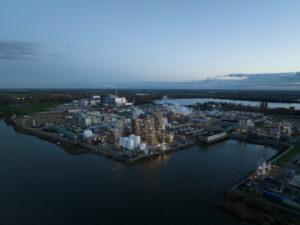Why Aren’t We Banning ‘Forever Chemicals’?
Cancer-causing PFAS are in 45% of our tap water. New government regulations won't fix that. Homes that flank an industrial zone are seen from the air Thursday, Feb. 23, 2023, in Commerce City, Colo, where the water is known to be contaminated by PFAS. (AP Photo/Brittany Peterson)
Homes that flank an industrial zone are seen from the air Thursday, Feb. 23, 2023, in Commerce City, Colo, where the water is known to be contaminated by PFAS. (AP Photo/Brittany Peterson)
Last week, the U.S. federal government rolled out its first-ever legally binding national drinking water standards for six “forever” chemicals present in the tap water of hundreds of millions of Americans. The new regulations, announced on April 10, require local drinking water systems to slash these chemicals down to near-zero levels.
Per- and polyfluoroalkyl substances, commonly referred to as “forever chemicals” due to their indestructible nature and tendency to accumulate in the body and environment, are ubiquitous. They are notoriously present in an array of everyday consumer products, from makeup and rain jackets to nonstick pans and menstrual products. They’re also in the tap water of nearly half of all Americans.
The new measure is designed to reduce public exposure to PFAS, which the Environmental Protection Agency has linked to a range of health problems, including decreased fertility, developmental delays in children and a higher risk of certain cancers. EPA head Michael Regan stated that the new standard “will reduce PFAS exposure for approximately 100 million people.” Additionally, the EPA expects these changes to “prevent thousands of deaths, and reduce tens of thousands of serious illnesses.”
While the new PFAS regulations represent significant progress, they merely scratch the surface of what’s needed to address the crisis fully.
Sarah Doll, national director of Safer States, an alliance of environmental health organizations dedicated to protecting people from toxic chemicals, corroborates this optimism. “It’s a big deal,” she told me. “The last time that any administration regulated a chemical under the Safe Drinking Water Act was in 1996.” She went on to explain how the leap forward reflects a growing acknowledgment of the insidious threat posed by these chemicals.
While the new PFAS regulations represent significant progress, they merely scratch the surface of what’s needed to address the crisis fully. These measures tackle PFAS contamination after it occurs, without addressing the ongoing production of these chemicals. Continuing to produce PFAS means the problem will persist, and cleaning contaminated water will remain a partial fix at best. Experts and scientific research advocate for a more comprehensive approach: a national ban on PFAS production.
At the moment, the U.S. federal government has neither the capability nor the willingness to pass such comprehensive legislation. This inaction reflects a weak federal structure and strong industry lobbies that prevent public health and environmental safety prioritization, reducing the government’s role to managing crises rather than preventing them.
In contrast, on Thursday, April 4, France’s National Assembly passed a near-total ban on PFAS production. Set to take effect in 2026, the legislation does include some exceptions due to industry lobbying. The French draft law specifically makes an exception for kitchen utensils thanks to effective lobbying by Groupe SEB, the world leader in nonstick frying pans, which convinced French Minister for Industry Roland Lescure that the law would “kill off French industry.” This move by France also hints at what increasingly looks like an EU-wide ban on the horizon.
Doll commented on the challenges of implementing such a ban in the U.S., stating that “the [American] federal system isn’t designed to effectively do that,” pointing to the intricate dance of politics and science that hampers decisive action. “The federal government is better positioned to think about downstream cleanup… less well positioned on the upstream side to mirror what France did.”
She went on to further explain how the current federal landscape, influenced by politics and industry interests, creates significant obstacles. The approach of slowly implementing incremental regulations, driven by lengthy litigation and legislative caution, does not meet the need for immediate action.
Another drawback of the new federal PFAS regulation is its financial impact on taxpayers. The EPA estimates that compliance will cost water utilities about $1.5 billion annually while a study commissioned by the American Water Works Association suggests these costs could soar to over $3.8 billion each year.
Some U.S. states have pursued legal action against chemical manufacturers to hold them accountable for contaminating drinking water supplies and to help subsidize the cleanup costs. For instance, 3M is expected to pay out $10.3 billion to settle multiple lawsuits related to water system contaminations. However, these settlement amounts are small compared to the extensive costs of cleaning up the contamination. Industry executives argue that these expenses will eventually be passed on to the public through higher water rates, further burdening taxpayers.
More significant progress in addressing PFAS contamination in the U.S. is taking place in Maine and Minnesota, two states that have passed laws similar to those in France, aiming to eliminate all uses of PFAS by 2030 and 2032, respectively.
Additionally, the regulation mandates that public water systems complete their initial monitoring for PFAS within three years and publicly disclose the detected levels. If these levels surpass safety standards, the systems have five years to implement strategies to reduce PFAS in their drinking water. This means that this limited strategy won’t come into effect until at least 2029.
More significant progress in addressing PFAS contamination in the U.S. is taking place in Maine and Minnesota, two states that have passed laws similar to those in France, aiming to eliminate all uses of PFAS by 2030 and 2032, respectively. Doll highlighted to me the impact of these state-level policies on the corporate landscape. She pointed to the example of Walmart, which will need to modify its supply chain to adhere to new PFAS restrictions in states like New York, California, Minnesota and Maine. This required adaptation may catalyze widespread changes throughout the retail and manufacturing sectors.
Another positive aspect of the state-level PFAS restrictions in Maine and Minnesota is their origin in a unified, bipartisan effort to enact comprehensive legislation. “Everybody wants clean water. Everybody wants to not be drinking carcinogens,” Doll stated, emphasizing the widespread consensus on the issue. Recognizing clean water and a toxin-free environment as fundamental rights could motivate both the public and policymakers, promoting initiatives that not only purify our water but also halt PFAS production.
Doll also highlighted a crucial element of state policy: the requirement for disclosure. She explained that a major issue is that both the public and regulators often don’t know what substances are present and where they are used. Addressing these information gaps is essential for understanding and managing PFAS risks more effectively. Increased awareness, partly spurred by federal regulation, is helping to build momentum.
But ultimately, says Doll, this is a production-side crisis. “Let’s stop creating the problem,” she says. “Let’s turn off the tap.”
Your support matters…Independent journalism is under threat and overshadowed by heavily funded mainstream media.
You can help level the playing field. Become a member.
Your tax-deductible contribution keeps us digging beneath the headlines to give you thought-provoking, investigative reporting and analysis that unearths what's really happening- without compromise.
Give today to support our courageous, independent journalists.







You need to be a supporter to comment.
There are currently no responses to this article.
Be the first to respond.